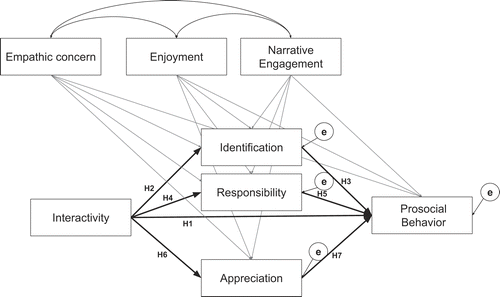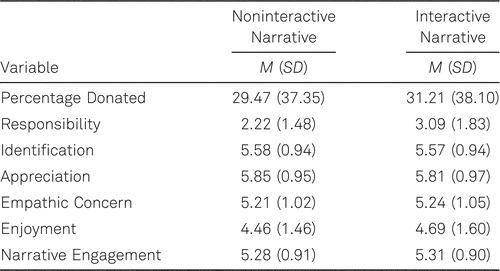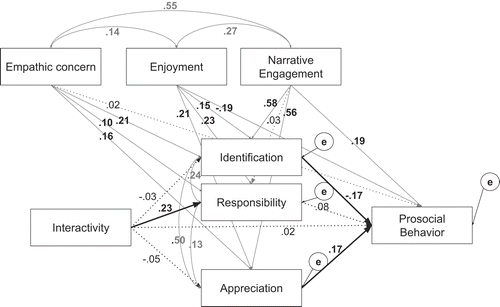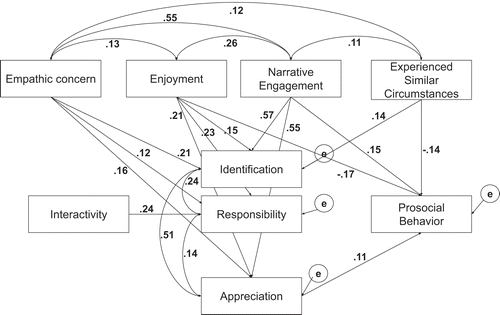Interactive Narratives Affecting Social Change
A Closer Look at the Relationship Between Interactivity and Prosocial Behavior
Abstract
Abstract. Interactive narratives offer interesting opportunities for the study of the impact of media on behavior. A growing amount of research on games advocating social change, including those focusing on interactive narratives, has highlighted their potential for attitudinal and behavioral impact. In this study, we examine the relationship between interactivity and prosocial behavior, as well as potential underlying processes. A yoked study design with 634 participants compared an interactive with a noninteractive narrative. Structural equation modeling revealed no significant differences in prosocial behavior between the interactive and noninteractive condition. However, support for the importance of appreciation for and engagement with a narrative on subsequent prosocial behavior was observed. In summary, while results shed light on processes underlying the relationship between both noninteractive and interactive narratives and prosocial behavior, they also highlight interactivity as a multifaceted concept worth examining in further detail.
A growing amount of research supports the idea that interactive narratives and games can be used not only for entertainment but also for education, health, and to further social change and prosocial behavior (Green & Jenkins, 2014; Steinemann, Mekler, & Opwis, 2015). Games for change are designed to motivate their players to support the social change they themselves are advocating. They have been created on a wide variety of subjects from the humanitarian crisis in Darfur (Darfur Is Dying), to the working poor in the United States (Spent), to the social status of women around the world (Half the Sky).
In recent years, studies have provided empirical support for the potential of interactive media to improve attitudes toward stigmatized groups (Ruggiero, 2015), increase willingness to help (Peng, Lee, & Heeter, 2010), and impart knowledge around peace efforts among people living in conflict zones (Kampf & Stolero, 2015). Notably, however, to our knowledge only one study to date has examined the effect of games for change on actual behavior. In that study, Steinemann et al. (2015) compared a game where the player takes the role of a refugee in Darfur, with an interactive text, a noninteractive text, and a video, all telling the same story as the game. After engaging with the story, participants were asked whether they would be willing to donate a percentage of a monetary reward they were receiving to a charity helping refugees in Darfur. The study found that participants in the interactive conditions (i.e., the interactive text and the game) donated significantly more than participants in the noninteractive conditions.
Understanding the impact that interactive media, such as games for change, can have on behavior, and specifically on prosocial behavior, is a highly interesting topic, both from an academic perspective (Ruggiero, 2015; Sundar, 2009) as well as from a practical perspective, as affecting behavior is arguably a crucial goal of games for change (Klimmt, 2009). In light of this first empirical support that games for change can indeed lead to prosocial behavior, the following sections will outline possible foundations for this effect.
Theoretical Background
Interactivity
Games for change vary widely in their visual presentation, use of game features, and narrative structure. What they have in common, however, is that each game puts players in a role they would most likely never encounter in their day-to-day life, has them make decisions in this role, and experience their narrative consequences (Green & Jenkins, 2014). This taking of an active role in the narrative is referred to as interactivity (Green & Jenkins, 2014).
While an exact definition of interactivity is hampered by the fact that different forms of media will exhibit interactivity in a wide variety of ways (Bucy & Tao, 2007; Sundar, 2009), especially for narrative-heavy games, their ability to allow decision-making is arguably one of interactivity’s most basic and defining features (Elson, Breuer, Ivory, & Quandt, 2014; Green & Jenkins, 2014).
Different studies have highlighted the importance of interactivity as crucial to the impact of games for change (Peng et al., 2010; Ruggiero, 2015; Steinemann et al., 2015). Notably, Steinemann et al. (2015) found an interactive text to be just as effective at increasing donations as an animated game. This finding lends credence to interactive texts as a valuable form of game for change. Indeed, several games for change already exist, which either are designed as interactive texts or rely heavily on interactive text as a primary game feature (e.g., Spent, Depression Quest, or NationStates). In this study, we therefore focus on interactivity in text-based narratives, as referring to decisions guiding the narrative, as opposed to, for example, dexterity-based interactivity possible in digital games.
Beyond empirically demonstrating the importance of interactivity to affect behavior, it is necessary to further understand the psychological processes that mediate this effect (Bucy & Tao, 2007). In the study by Steinemann et al. (2015), for instance, the effect of interactivity on donating behavior was mediated by appreciation.
Yet none of the other examined factors, which included willingness to help and enjoyment, were both impacted by interactivity and positively related to donating. The aim of this study therefore is to more closely examine the relationship between interactivity and prosocial behavior. Hence, we refer to the theoretical model of Green and Jenkins (2014), which discusses a number of variables that may help to explain the processes involved in the effects of interactive narratives on outcomes such as behavior (see Figure 1). In this model, interactivity leads to behavioral change by giving the reader control and allowing them to adapt the narrative structure (i.e., the course of the story) according to their individual personality and interests. This in turn leads to engagement (which includes factors such as identification) and allows the reader to play with different roles of the self, for example, by an increased sense of responsibility toward the characters in the interactive narrative or by exploring different aspects of their personality through possible selves presented in the narrative. Together, these variables are expected to impact outcomes such as enjoyment, appreciation, and attitudinal and behavioral change.

The current study aims to empirically examine some of these processes. We focus on variables that may be of particular interest when attempting to explain the impact of interactivity on prosocial behavior as the outcome.
Prosocial Behavior
While there is still little research specifically about the impact of games for change on actual behavior, the study by Steinemann et al. (2015) gives a first indication for such an effect, and interactivity as its source. While prosocial behavior can manifest itself in countless ways, in the study by Steinemann et al. (2015) prosocial behavior was instrumentalized as the percentage that, after engaging with a narrative, participants donated to a charity helping people like the main character in the narrative. Based on these results, combined with the findings of other studies that link interactive media with increased prosocial attitudes and behaviors (Green & Jenkins, 2014; Ruggiero, 2015), we hypothesize that:
Interactivity will lead to a higher percentage donated.
Identification
In the context of media, identification describes the process of taking on the role of a character and sharing their goals and emotions (Cohen, 2001). In contrast to engagement with the narrative world, identification describes the merging with a character (Green & Jenkins, 2014). This merging with a character is facilitated by interactivity, as interactivity allows the player to choose actions for the character, which they personally agree with (Vorderer, Knobloch, & Schramm, 2001).
According to social identity theory, identification is crucial in the categorization of in- and outgroups, creating the line between people an individual will consider to be like themselves and treat more favorably and those they will not (Hogg, 2003). Identification has its basis in empathy, itself a well-established predecessor of prosocial behavior (Eisenberg & Miller, 1987). In the context of games for change, increased identification has been associated with higher willingness to help (Peng et al., 2010) and donating behavior (Steinemann et al., 2015).
We therefore hypothesize that:
Interactivity will lead to more identification with the character.
Identification will be positively related to a higher percentage donated.
Responsibility
As argued by Green and Jenkins (2014), while empathy with a character may occur in noninteractive narratives, feeling responsible for their actions is rare. By making decisions in the interactive narrative, however, the reader can see a direct link between their actions and their consequences. Through this sense of agency over the narrative, the likelihood of feeling responsible for the outcome and how it affects the main character increases (Green & Jenkins, 2014). A lack of agency has been associated with an increase in moral disengagement, which in turn is related to a decrease in prosocial behavior (Bandura, Barbaranelli, Caprara, & Pastorelli, 1996). Alternately, priming participants on their responsibility can increase empathy, which is related to prosocial behavior (Čehajić, Brown, & González, 2009). While there are no studies directly linking responsibility with prosocial behavior in interactive narratives, on the basis of these findings we hypothesize that:
Hypothesis 4 (H4): Interactivity will lead to more responsibility.
Responsibility will be positively related to a higher percentage donated.
Appreciation
Finally, appreciation describes media experiences that are valued not necessarily for being fun but for their capability to be meaningful, moving, and thought-provoking (Oliver & Bartsch, 2010); such as when the player’s character has to make a hard choice in the narrative.
While games research has long focused primarily on enjoyment, recent studies have highlighted the ability of games to lead to meaningful experiences (Elson et al., 2014; Oliver et al., 2015; Steinemann et al., 2015). A possible explanation for this effect is that interactivity may allow players to create a story that is more personally meaningful to them than a noninteractive equivalent (Elson et al., 2014).
Both feelings of meaningfulness as well as the ability of media to be moving have been repeatedly associated with increased likelihood of compassion and prosocial behavior (Morgan, Movius, & Cody, 2009; Myrick & Oliver, 2015; Small & Simonsohn, 2008). Furthermore, in the study by Steinemann et al. (2015) appreciation was not only higher in the interactive condition, it was also positively related to an increase in donations.
In the conceptual model of Green and Jenkins (2014), appreciation is an outcome, similar to behavior. However, as behavior is the focus of this study and because of the aforementioned research linking appreciation with both interactivity and prosocial behavior, we will treat appreciation as an additional process between interactivity and prosocial behavior (see Figure 2).

We therefore expect that:
Interactivity will lead to more appreciation.
Appreciation will be positively related to a higher percentage donated.
While identification, responsibility, and appreciation offer the clearest indications for their role as mediators between interactivity and prosocial behavior, other variables should also be considered in a comprehensive model of these processes. Therefore, we also controlled for the role of three additional variables. To control for individual differences in empathy, which may particularly impact identification, empathic concern was included (Cohen, 2001). Additionally, enjoyment, which is related to appreciation (Oliver & Bartsch, 2010), and narrative engagement (Busselle & Bilandzic, 2009), which may be related to all three potential mediators, was controlled for (see Figure 2).
To sum up, the goal of this study was to examine how an interactive narrative, compared with a noninteractive narrative, impacts prosocial behavior, identification with the character, responsibility toward the character, and appreciation of the narrative experience. Furthermore, we examined how these different variables in turn relate to prosocial behavior (see Figure 2). Thereby, the results offer a closer empirical examination of the theoretical model of Green and Jenkins (2014), as well as allowing a more sophisticated look at the relationship between interactivity and prosocial behavior.
Method
Ethics Statement
This research was registered with the Institutional Review Board of the authors’ university. Written informed consent was obtained from all participants.
Design
To test our hypotheses, a between-subject experimental design was utilized. The independent variable was interactivity (interactive, noninteractive). The primary dependent variable was prosocial behavior, measured as the percentage of the reward that participants donated at the end of the study. The further dependent variables – expected to mediate the relationship between interactivity and prosocial behavior – were identification, responsibility, and appreciation. Empathic concern, enjoyment, and narrative engagement were added to the model as control variables.
An additional variable, text comprehension, served as a quality check and was analyzed across groups prior to testing the model, to ensure that interactivity did not affect participants’ ability to understand the text.
Participants
To achieve an acceptable power for the specified model (see Figure 2), a sample of 580 was needed. To ensure we would conclude with a sufficient sample size, we aimed to recruit approximately 730 participants on the crowdsourcing platform CrowdFlower (http://www.crowdflower.com).1 As recruitment over this platform was slow, Mechanical Turk was also included (https://www.mturk.com/mturk/).2
In all, 854 participants finished the study, of whom 796 correctly answered a bogus item (“This is a control item, please select ‘completely disagree’”). To ensure data quality, an additional 162 participants were subsequently excluded, due to technical issues (n = 7), outliers (±3.00 SD) in completion time (n = 81), indicating that they had not carefully answered the study questions (n = 9), participating more than once (n = 25), and answering less than three out of six of the text comprehension questions correctly (n = 40). The final dataset consisted of a total sample of 634 participants (331 in the interactive, 303 in the noninteractive condition).
To ensure the samples collected on Mechanical Turk (n = 270) and CrowdFlower (n = 363) did not differ significantly in terms of the impact of interactivity on the dependent variables, a two-way multivariate analysis of variance (MANOVA) was conducted to examine the combined effects of platform and condition on identification, responsibility, appreciation, and donation. A significant main effect for condition was found (p < .001), but neither the main effect for platform, nor the interaction effect between platform and condition reached significance (p-values between .53 and .97). Therefore the two samples did not differ in terms of hypothesis-relevant effects.
To examine whether text comprehension differed between the interactive (M = 5.27, SD = 0.62) and noninteractive condition (M = 5.25, SD = 0.93), Welch’s two-sample t test was conducted. No significant difference was found (p = .419).
As good English skills were essential for understanding the questionnaires and the stimulus material, we restricted recruitment to countries with English as a primary language. The majority of participants reported their nationality as US American (n = 301), Canadian (n = 106), or British (n = 96), with the remaining 131 reporting one of 31 other nationalities. Of the participants, 381 identified as female, 245 as male, three as transgender or non-binary, and four preferred not to say. Participants reported a wide variety of employment types, the largest groups being professional or managerial (n = 268), unemployed (n = 111), student (n = 91), blue collar or service (n = 80), and self-employed (n = 84).
Participants received US $0.2 for their participation, which they received after entering a code on CrowdFlower or Mechanical Turk that they were awarded at the end of the study. In addition, they received a reward of up to US $1 for carefully filling out the questionnaires and open questions, with respect to the aforementioned data quality checks. A percentage between 0% and 100% of this reward could be donated and served as our measure of prosocial behavior.
Stimuli
An interactive and a noninteractive version of a narrative were created using the authors’ university webserver. Both versions contained the same story, told over 23 paragraphs. The text was based on the article “How I Became Homeless” (Marcus, 2014, December), which tells the story of how a single parent with three children becomes unexpectedly homeless and the struggles they face while trying to find a place to stay.
For the interactive condition, eight decisions were added (e.g., opening a letter immediately or waiting until the evening) and the original article’s text was slightly modified (e.g., sentences were added in order to include the decisions). These decisions were designed to feel impactful, but at the same time to have a minimal impact on the narrative (e.g., choosing to open a letter a day later would lead to losing 1 day out of 4 for packing, but had no further impact on the story). However, to further ensure that the content of the specific decisions would not confound the effect of interactivity on our dependent variables, a yoked design was used. Therein, every time a participant in the interactive condition finished their version of the story based on their decisions, this version was saved and given to a participant in the noninteractive condition. This meant that the story was presented in as many different versions in the noninteractive condition as in the interactive condition. This “yoking” of the story version presented across conditions insured any differences between the two groups would be due to interactivity and not due to differences in the story or information presented.
The yoked design was implemented using Storyboard (Version 0.1), a software developed by the fifth author. The software utilizes a MySQL database and the PHP programming language. User interactions were recorded in our user tracking solution Datamice (Version 0.4) that was implemented with jQuery, PHP, Zend Framework, and MySQL.
An example of a noninteractive version of the story and the interactive story, as well as the code for the yoked design, can be viewed on the Open Science Framework website.3
Measures
Donating Behavior
Donating behavior was measured by asking participants which percentage of their participation reward they wished to donate to a charity. The charity chosen for this study was Habitat for Humanity, a nonprofit organization that aims to build and rehabilitate affordable houses around the world so as to help eliminate homelessness (http://www.habitat.org/). Participants chose the amount to donate from a drop-down list of ten-percent increments from 0% (no donation) to 100% (complete donation). This method was a slightly modified version of the method used by Steinemann et al. (2015), which informed participants of their reward in advance (instead of it being an unexpected bonus). This was done to increase the likelihood that participants would treat this money as their own (Clark, 2002). While US $1 was a fairly small amount of money, several previous studies have utilized this or similarly small amounts to examine donating behavior (e.g., Steinemann et al., 2015; Tsvetkova, Macy, & Szolnoki, 2014).
Responsibility
To measure responsibility, the 2-item scale by Jenkins (2014) was used (Cronbach’s α = .95), which asks participants to which extent they feel responsible for the outcome of the story and the character’s decisions.
All items for this and all following measures were presented on a 7-point Likert scale (1 = strongly disagree, 7 = strongly agree).
Identification With the Character and Empathic Concern
The 10-item identification scale by Cohen (2001) was used to measure identification with the main character (Cronbach’s α = .92). The items for this as well as all following measures were modified to be applicable for both interactive and noninteractive narratives. To control for individual differences in empathy, the 7-item Empathic Concern subscale by Davis (1983) was used (Cronbach’s α = .87).
Appreciation and Enjoyment
Appreciation (Cronbach’s α = .88) and enjoyment (Cronbach’s α = .89) were measured using the scale developed by Oliver and Bartsch (2010). This scale contains three items each for appreciation, that is, how meaningful, moving, and thought-provoking the story was, and enjoyment, that is, to which extent reading through the story was fun, considered a good time, and entertaining.
Narrative Engagement
To control for narrative engagement, the 12-item scale for narrative engagement developed by Busselle and Bilandzic (2009) was used (Cronbach’s α = .85).
Text Comprehension
Based on the questionnaire originally developed for viewing comprehension by Hobbs and Frost (2003), a 6-item questionnaire was included to control for text comprehension. While the original questionnaire asked for open answers, considering our large sample size a multiple-choice format was used.
Procedure
After clicking on a link on CrowdFlower or Mechanical Turk, participants were informed on an introduction page of the approximate time that the study would take and that they would be receiving a US $1 reward for careful completion of the study, next to the upfront payment of US $0.2. Next, participants were asked to fill out the questionnaire for empathic concern. Following this, participants were randomly assigned to one of the experimental conditions. Afterward, participants were asked to fill out the identification, responsibility, appreciation, enjoyment, and narrative engagement questionnaires. Next, participants were thanked and told that they now had the opportunity to donate a percentage of their US $1 reward to a charity. The percentage they chose to keep for themselves was later given to them as a bonus on CrowdFlower or Mechanical Turk; the percentage they wished to have donated was donated to the charity. Finally, participants were asked to fill out the text comprehension questionnaire and demographic questions (including a 1-item question on whether they had experienced circumstances similar to the ones described in the narrative), thanked a second time, and given a code to enter on their respective crowdsourcing platform in order to receive their compensation and reward.4
Results
The dataset and R script used in this analysis can be found on the Open Science Framework.5
Preliminary Analysis
Using boxplots, univariate outliers were detected for empathic concern, narrative engagement, identification, and appreciation. These variables were subsequently winsorized (threshold: 95%) to minimize the influence of the outliers on the statistical estimates.
Inspecting normal Q-Q plots, the distributions of donation and responsibility were found to be substantially non-normally distributed. Additionally, inspection of the scatterplots of the standardized residuals against the standardized predicted scores indicated the presence of heteroscedasticity among residuals, likely due to the non-normal distribution of donation and responsibility (Kline, 2011). Therefore, subsequent analyses were conducted using bootstrapping and Spearman’s rank correlation, as they are robust to violations of normality. Examination of the scatterplots indicated that all visible relations between the outcome variables were linear.
Means and standard deviations for all dependent and control variables across the two levels of interactivity are listed in Table 1. Participants in both conditions donated approximately 30% of their reward to the charity, which resulted in a total donation of US $214 for Habitat for Humanity. Further, the high values for identification and appreciation indicated that in both conditions, participants identified strongly with the character and found the story to be meaningful. Spearman’s rank correlations are listed in Table 2. Of special note are the high correlations between appreciation, identification, and narrative engagement, contrasted with the fairly low correlations with donation.


Model Estimation
To test H1–H7 (Figure 2), a path analysis model was estimated with R (R Core Team, 2016) and the package lavaan (Rosseel, 2012), using standard error-bootstrapping and Satorra–Bentler correction due to non-normality (Kline, 2011).
Inspection of the fit indices showed the resulting model to have a good fit, χ2 = 3.68, df = 3, p = .299, comparative fit index (CFI) = .99, root mean square of approximation (RMSEA) = .02, 90% CI [.00, .07]. This model can be seen in Figure 3.

Next, the importance of the control variables empathic concern, enjoyment, and narrative engagement was examined by trimming the paths between them and the dependent variables. A χ2 difference test determined that the trimming of these paths resulted in a significantly poorer fit (χ2diff = 927, dfdiff = 15, p < .001). Therefore, the original model was retained.
Despite the high covariance between identification, appreciation, and narrative engagement, multicollinearity was within acceptable ranges (VIF between 2.40 and 3.14, tolerance values between .32 and .42; Field, Miles, & Field, 2013).
Confirmatory Analysis
Hypotheses were tested using the estimated model (Figure 3). Our first hypothesis predicted that interactivity would lead to a higher percentage donated. This was not supported (β = .02, b = 0.01, SE = 0.03, p = .696). H2 and H3 predicted that interactivity would lead to more identification, which in turn would lead to a higher percentage donated. H2 was not supported (β = −.03, b = −0.06, SE = 0.05, p = .169), whereas for H3 a significant relationship in the opposite direction was found, with identification being negatively related to percentage donated (β = −.17, b = −0.07, SE = 0.03, p = .013). H4 and H5 predicted that interactivity would lead to more responsibility, which in turn would be related to a higher percentage donated.
H4 was supported (β = .23, b = 0.80, SE = 0.12, p < .001), while H5 was not (β = .08, b = 0.02, SE = 0.01, p = .08). H6 and H7 predicted that interactivity would lead to more appreciation, which in turn would be related to a higher percentage donated. H6 was not supported (β = −.05, b = −0.10, SE = 0.05, p = .056); however, H7 was supported (β = .17, b = 0.07, SE = 0.02, p = .005). An overview of all hypotheses and corresponding results can be seen in Table 3.

Exploratory Analysis
As 148 participants (23.30% of the study sample) indicated that they had themselves experienced circumstances similar to the ones described in the narrative, we added “experienced similar circumstances” (yes/no) as a further control variable into the model, as this may have simultaneously facilitated identification with the character in the story, while also making participants less likely to donate as they might still be in more difficult financial circumstances than someone who had never experienced similar circumstances. The resulting model had a good fit, χ2 = 3.82, df = 4, p = .431, CFI = 1.00, RMSEA = .00, 90% CI [.00, .06]. Of particular interest is the finding that the previously negative relationship between identification and donation was no longer significant in this model (β = −.12, b = −0.05, SE = 0.03, p = .112), but that instead having experienced similar circumstances was significantly negatively related to donation (β = −.13, b = −0.11, SE = 0.03, p = .001).
To further improve the model, the nonsignificant paths between experienced similar circumstances and appreciation and responsibility as well as the nonsignificant covariance between experienced similar circumstances and enjoyment were trimmed. A χ2 difference test showed this to not significantly reduce the model fit (χ2 = 3.33, dfdiff = 3, p = .34). Next, the nonsignificant paths from interactivity to identification, appreciation, and donation as well as the nonsignificant paths from identification to donation, responsibility to donation, empathic concern to donation, and narrative engagement to responsibility were trimmed. A χ2 difference test showed this trimming to likewise not significantly reduce the model fit (χ2 = 12.7, dfdiff = 10, p = .239).
The resulting model fit was good, χ2 = 16.60, df = 14, p = .278, CFI = 0.998, RMSEA = .02, 90% CI [.00, .04]. This exploratory model can be seen in Figure 4.6

Discussion
This study aimed to investigate how and why interactive narratives may impact prosocial behavior. Of the variables examined, responsibility alone was impacted by interactivity. Prosocial behavior was positively related to appreciation and narrative engagement and negatively related to enjoyment, and (in the confirmatory analysis) with identification. Responsibility and empathic concern were not significantly related to prosocial behavior. Narrative engagement was strongly related to both identification and appreciation.
The clearest result found was that interactivity in the form examined did not impact the percentage donated. These findings are in contrast to those previously found in other studies (Green & Jenkins, 2014; Peng et al., 2010; Ruggiero, 2015; Steinemann et al., 2015).
One possible explanation is that the experimental manipulation of interactivity did not work. However, considering that here interactivity was defined merely in terms of the ability to allow decision-making, which the story did, and the finding that participants did experience more responsibility for the story and the character, which have previously been strongly associated with interactivity (Green & Jenkins, 2014), the conditions did appear to differ, at least in these most basic respects.
If, therefore, the conditions can be argued to differ in terms of interactivity, but the effects of interactivity were not comparable to those found in other studies on prosocial behavior and attitudes, it begs the question of whether the form of interactivity examined across these studies may have differed in fundamental ways, which would account for these differences.
To attempt to answer this question, we take a closer look at the stimuli used in this study compared with studies that have previously found interactivity to affect prosocial behavior and attitudes (Peng et al., 2010; Ruggiero, 2015; Steinemann et al., 2015). In the current study, a noninteractive article about a single parent who becomes homeless was used as a basis, to which interactive elements were added to examine the difference between an interactive and noninteractive story. The actions included options such as deciding whether to stay with one’s mother or one’s best friend, or how to respond to uncomfortable questions asked by coworkers. The interactive narrative ended for all players with a friend offering them and their children a place to stay for as long as they wished. While these decisions were designed to feel meaningful, they differed notably from the decisions in the interactive conditions used in the study by Peng et al. (2010), Ruggiero (2015), and Steinemann et al. (2015), who utilized the games for change Spent or Darfur Is Dying. In Darfur Is Dying, the player takes up the role of a person living in a refugee camp, who must venture out of the camp while having to avoid being captured by the militia patrolling the area. In Spent, the player is a single parent who recently lost their job and must try and survive the month on US $1,000, while facing difficult choices, such as whether or not to send their child to an expensive gifted program. While these games tackle separate issues using different design approaches, they do have two crucial factors in common. First, almost every decision in the game had drastic consequences – either bringing the player ever closer to being caught by the militia or running out of money. Often, one wrong decision could mean losing the game. Second, both games are quite difficult; in Steinemann et al. (2015) for example, the vast majority of players of Darfur Is Dying lost the game. Contrasted with the far less severe consequences of choosing to stay with one’s mother or a friend and ultimately ending up in a safe and stable environment, it could be argued that the decisions made in games such as Darfur Is Dying and Spent could be experienced as far more important and meaningful. Described in terms used by Green and Jenkins (2014), user control over the narrative structure was likely more strongly felt when players could see the clear consequences of their actions. This is supported by previous research that has found that inspirational and motivational video clips were only associated with increased prosocial behavior when combined with perceived choice (Ellithorpe, Ewoldsen, & Oliver, 2015). Yet another study found that participants were more satisfied making decisions instead of having a decision made for them only when they clearly could differentiate between two options and that only the differentiated options led to a higher sense of responsibility (Botti & McGill, 2006). In the current study, while responsibility did differ between the interactive and noninteractive conditions, responsibility in neither condition was particularly high. The low sense of responsibility even in the interactive narrative could well be due to the fact that decisions were rarely followed by clear consequences, for example, opening the letter in the morning instead of the evening led to a day less time to pack, but had no further consequence or lasting repercussions.
Furthermore, the most important positive relationships with prosocial behavior were engagement with and appreciation for the narrative. We first hypothesized that interactivity would lead to more appreciation (Elson et al., 2014; Oliver et al., 2015; Steinemann et al., 2015) and this in turn would relate to more prosocial behavior (Morgan et al., 2009; Myrick & Oliver, 2015; Small & Simonsohn, 2008). Perhaps, however, the concept of interactivity should be considered in more nuanced terms than this, in that interactivity can lead to more appreciation by the meaningfulness of the decisions this interactivity entails. In other words, the more meaningful interactivity is perceived, the more appreciation is felt and the more this will in turn lead to prosocial behavior.
While further research comparing different forms of interactive narrative is necessary, the present findings suggest that interactivity is more complex than simply adding decisions to a story. Taken together, the differences between interactive narratives used in the current study and those used by Peng et al. (2010), Ruggiero (2015), and Steinemann et al. (2015) imply that decisions must feel meaningful and offer clear consequences with emotional ramifications for the player. To be more effective than their noninteractive counterparts, the interactive narrative must be capable of impacting variables such as appreciation and narrative engagement.
Another possible explanation for the failure to find a relationship between interactivity and prosocial behavior could be that interactivity does in fact not lead to an increase in prosocial behavior. Arguably, previous studies have suffered from methodological drawbacks, with the studies of both Peng et al. (2010) and Steinemann et al. (2015) being underpowered, which may have led to an over-estimation of effects (Button et al., 2013). Furthermore, to our knowledge no previous studies examining the effects of interactivity on prosocial behavior or attitudes have utilized a yoked design (e.g., Peng et al., 2010; Ruggiero, 2015; Steinemann et al., 2015). Yoked designs have been used in the past to allow for conclusive results on the effects of interactivity on a number of topics from neural activation (Cole, Yoo, & Knutson, 2012) to learning performance (Kickmeier-Rust, Marte, Linek, Lalonde, & Albert, 2008) to the amount of voluntary reading children with dyslexia are willing to do (Ward, McKeown, Utay, Medvedeva, & Crowley, 2012). When the interactive and noninteractive condition are not yoked, it becomes difficult to ensure that any differences between the conditions are truly due to interactivity and not due to differences in the information presented in the conditions. Owing to the high power of the present study, its employment of a yoked design, as well as the use of a preregistered confirmatory analysis, the finding that interactivity does not impact prosocial behavior – at least under the conditions used in this study – can be assumed to be robust. To examine whether interactivity affects prosocial behavior under other conditions, future studies should therefore aim both for sufficient power and, importantly, for the use of a yoked design. Preregistry of confirmatory analysis is recommendable for research across fields.
While interactivity failed to impact any processes save responsibility in the estimated model, a number of interesting effects between the examined psychological processes and prosocial behavior were observed. For one, the positive relationship between appreciation and prosocial behavior corroborates previous findings (Steinemann et al., 2015), further establishing appreciation as an important experience to consider when designing for prosocial behavior in contexts such as, but not limited to, games for change. The previously unexamined positive relationship between narrative engagement and prosocial behavior suggests an interesting factor to keep in mind in further research.
The negative effect of identification on prosocial behavior was unexpected. The exploratory analysis provided a possible explanation, as having oneself experienced similar circumstances to those depicted in the narrative was associated both with higher identification with the character and a smaller donation. Including this variable in the model led the negative relationship between identification and prosocial behavior to disappear. A possible interpretation could be that having experienced similar circumstances to those of a homeless family might be associated with an increased chance of still being in difficult circumstances, potentially needing the money more, and therefore being less willing to donate. It is also possible that in the context of the story used in this study, experiencing similar circumstances, and thereby identifying more with the character, affected donations negatively, because participants who had experienced similar circumstances in the past did not believe that donations to charities would necessarily improve the situation of the person affected. In future studies, it may therefore be worth controlling for perceived efficacy of proposed solutions. However, even controlling for the effect of previous experience, the hypothesized positive relationship between identification and prosocial behavior was not observed in the model. Considering that instead appreciation and narrative engagement were related to prosocial behavior, this may suggest that, at least under certain circumstances, a narrative’s meaningfulness and its ability to engage the reader may perhaps be more important for promoting prosocial behavior than character identification is (Bartsch, Kalch, & Oliver, 2014; Small & Simonsohn, 2008). Put differently, a reader could identify with a character or a character’s action, but would not necessarily think of the issue as meaningful or engaging enough to donate.
Enjoyment being negatively related to prosocial behavior, while appreciation was positively related, further supports the differentiation between these two forms of media experience (Oliver & Bartsch, 2010). For games for change, the findings that the less fun and entertaining, yet the more meaningful and moving the experience is, the more people will donate at the end, hints at the importance of focusing on creating experiences that are appreciated rather than enjoyed (Bartsch et al., 2014; Myrick & Oliver, 2015; Steinemann et al., 2015). This finding comes, however, with the caveat that this is solely related to whether people will donate. Other experiences, such as willingness to share the interactive narrative with other people or starting to play in the first place, may be impacted by the degree of enjoyment experienced or expected to be experienced (Cohen, 2014). Further research on the impact of appreciation and enjoyment on prosocial behavior other than donating is therefore recommended.
Limitations and Outlook
While this study offers several promising findings, it also has clear limitations. Most importantly, the main question of this study of how and why interactivity impacts prosocial behavior presupposed that a significant impact of interactivity on prosocial behavior would be found. As this was not the case, mediation effects could not be observed. While these remain interesting research questions, the findings of this study as they were observed may offer valuable insights into why interactivity may work in some cases but not in others. Future studies on the relationship between interactive narratives and prosocial behavior should therefore carefully consider how interactivity is manipulated, in particular whether the decisions are considered meaningful by participants.
Furthermore, the high values for appreciation and identification may have led to a ceiling effect, which would make differentiating between experimental conditions more difficult and therefore may have impeded the analysis. However, while not the main focus of the study, the positive relationship of appreciation, narrative engagement, and prosocial behavior suggests interesting avenues for future research on interactive narratives. For example, the possibility of losing and facing negative consequences when wrong decisions are made, or the simple uncertainty of the outcome and the resulting suspense, may be crucial factors worth future study (Hall, 2015; Ruggiero & Becker, 2015).
Conclusion
The results of this study support the importance of appreciation, enjoyment, and narrative engagement in the context of media trying to further prosocial behavior.
The results, however, also indicate that the relationship between interactivity and prosocial behavior may not be as simple as previously assumed. We argue that examination of further interactivity-related variables, such as the emotional consequences of decisions made, as well as the outcome of the story (i.e., whether one can lose or experience a negative outcome), may be crucial elements when creating interactive narratives with the goal of encouraging prosocial behavior. Lastly, while donating behavior as an instrumentalization of prosocial behavior is both relevant and meaningful, other behavioral consequences of interacting with narratives, for example, how willing people are to share the narrative with friends or to start reading the narrative in the first place, may offer interesting themes for future research.
We would like to sincerely thank Markus Stöcklin, Mathias Jenny, and Michelle Wobmann for their valuable advice and assistance. Furthermore we would like to express our warmest gratitude to the editors, Malte Elson and Andrew K. Przybylski, and to the anonymous reviewers, who throughout the development phases of this preregistered research offered careful, competent, and extremely helpful feedback.
Sharon Steinemann is a research assistant and PhD candidate in the Human-Computer Interaction Lab at the Center for Cognitive Psychology and Methodology at the University of Basel. Her research interests focus on the impact of interactive media on prosocial behavior and attitude change and understanding the psychological processes involved.

Glena Iten is a research assistant and PhD candidate in the Human-Computer Interaction Lab at the Center for Cognitive Psychology and Methodology at the University of Basel. Her research interests focus on media recovery, moral reasoning in games, and applied cognitive psychology.

Klaus Opwis is a Full Professor for Cognitive Psychology and Methodology at the University of Basel. His research interests focus on applied cognitive psychology (e.g., training of working memory, HCI, aesthetics, and visual perception) and on methodological topics (e.g., measurement theory, structural equation models).

Seamus Forde is a HCI Master’s student and research assistant at the HCI research group at the University of Basel. His research interests focus on computer games, gamification, and motivation.

Lars Frasseck is a research associate and software engineer at the Department of Psychology at the University of Basel. His research interests focus on web software as means for data collection and analysis in psychological studies.

Elisa Mekler is a post-doctoral fellow at the HCI Games Group at the University of Waterloo. Her research focuses on the characteristics of enjoyable and meaningful user experiences with games, gamification, and interactive technology in general. She is particularly interested in the value of emotional experiences with technology and their potential to motivate attitude and behavior change.

1Recruitment on CrowdFlower took place from June 2, 2016, to July 13, 2016.
2Recruitment on Mechanical Turk took place from July 8, 2016, to July 12, 2016.
3Our project InteractiveNarratives can be accessed at https://osf.io/jstzv/
4In order to donate and pay out the correct amounts to participants, participants received different codes depending on the amount they had chosen to donate.
5InteractiveNarratives (https://osf.io/jstzv/)
6Further analysis conducted included analysis of variance for all four outcome variables, which found the same effects as the pathway analysis (i.e., responsibility was the only variable that was significantly different across the conditions of interactivity) and a multiple group analysis to test for a moderation effect of “experienced similar circumstances,” which, however, found no significant differences in model fit. More information on these analyses can be found on the Open Science Framework.
References
(1996). Mechanisms of moral disengagement in the exercise of moral agency. Journal of Personality and Social Psychology, 71(2), 364.
(2014). Moved to think: The role of emotional media experiences in stimulating reflective thoughts. Journal of Media Psychology, 26(3), 125.
(2006). When choosing is not deciding: The effect of perceived responsibility on satisfaction. Journal of Consumer Research, 33(2), 211–219.
(2007). The mediated moderation model of interactivity. Media Psychology, 9(3), 647–672.
(2009). Measuring narrative engagement. Media Psychology, 12(4), 321–347.
(2013). Power failure: Why small sample size undermines the reliability of neuroscience. Nature Reviews Neuroscience, 14(5), 365–376.
(2009). What do I care? Perceived ingroup responsibility and dehumanization as predictors of empathy felt for the victim group. Group Processes & Intergroup Relations, 12(6), 715–729.
(2002). House money effects in public good experiments. Experimental Economics, 5(3), 223–231.
(2014). What makes good games go viral? The role of technology use, efficacy, emotion and enjoyment in players’ decision to share a prosocial digital game. Computers in Human Behavior, 33, 321–329.
(2001). Defining identification: A theoretical look at the identification of audiences with media characters. Mass Communication & Society, 4(3), 245–264.
(2012). Interactivity and reward-related neural activation during a serious videogame. PLoS One, 7(3), e33909. doi: 10.1371/journal.pone.0033909
(1983). Measuring individual differences in empathy: Evidence for a multidimensional approach. Journal of Personality and Social Psychology, 44(1), 113.
(1987). The relation of empathy to prosocial and related behaviors. Psychological Bulletin, 101(1), 91.
(2015). Elevation (sometimes) increases altruism: Choice and number of outcomes in elevating media effects. Psychology of Popular Media Culture, 4(3), 236.
(2014). More than stories with buttons: Narrative, mechanics, and context as determinants of player experience in digital games. Journal of Communication, 64(3), 521–542.
(2013). Discovering statistics using r. London, UK: Sage.
(2014). Interactive narratives: Processes and outcomes in user-directed stories. Journal of Communication, 64(3), 479–500.
(2015). Entertainment-oriented gratifications of sports media: Contributors to suspense, hedonic enjoyment, and appreciation. Journal of Broadcasting & Electronic Media, 59(2), 259–277.
(2003). Measuring the acquisition of media-literacy skills. Reading Research Quarterly, 38(3), 330–355.
(2003). Social identity. New York, NY: Guilford Press.
(2014). Choose your own adventure: Interactive narratives and attitude change. (Unpublished doctoral dissertation). The University of North Carolina at Chapel Hill.
(2015). Computerized simulation of the Israeli–Palestinian conflict, knowledge gap, and news media use. InformationCommunication & Society, 18(6), 644–658.
(2008).
The effects of individualized feedback in digital educational games . In T. ConollyM. StansfieldEds., Proceedings of the 2nd European Conference on Games Based Learning (pp. 227–236). Barcelona, Spain: Academic Publishing.(2009).
Serious games and social change: Why they (should) work . In U. RitterfeldM. CodyP. VordererEds., Serious games: Mechanisms and effects (pp. 248–270). New York, NY: Routledge.(2011). Principles and practice of structural equation modeling. New York, NY: Guilford Publications.
(2014, December). How I became homeless. Retrieved from http://www.salon.com/2014/12/25/how_i_became_homeless
(2009). The power of narratives: The effect of entertainment television organ donation storylines on the attitudes, knowledge, and behaviors of donors and nondonors. Journal of Communication, 59(1), 135–151.
(2015). Laughing and crying: Mixed emotions, compassion, and the effectiveness of a YouTube PSA about skin cancer. Health Communication, 30(8), 820–829.
(2010). Appreciation as audience response: Exploring entertainment gratifications beyond hedonism. Human Communication Research, 36(1), 53–81.
(2015). Video games as meaningful entertainment experiences. Psychology of Popular Media Culture, 1–16. doi: 10.1037/ppm0000066. Advance online publication
(2010). The effects of a serious game on role-taking and willingness to help. Journal of Communication, 60(4), 723–742.
. (2016). R: A language and environment for statistical computing [Computer software manual]. Vienna, Austria: Retrieved from https://www.R-project.org/
(2012). lavaan: An R package for structural equation modeling. Journal of Statistical Software, 48(2), 1–36. Retrieved from http://www.jstatsoft.org/v48/i02/
(2015). The effect of a persuasive social impact game on affective learning and attitude. Computers in Human Behavior, 45, 213–221.
(2015). Games you can’t win. The Computer Games Journal, 4(3–4), 169–186.
(2008). Friends of victims: Personal experience and prosocial behavior. Journal of Consumer Research, 35(3), 532–542.
(2015). Increasing donating behavior through a game for change: The role of interactivity and appreciation. Proceedings of the 2015 Annual Symposium on Computer-Human Interaction in Play. New York, NY: ACM, 319–329.
(2009).
Media effects 2.0: Social and psychological effects of communication technologies . In R. L. NabiM. B. OlivesEds., The Sage handbook of media processes and effects (pp. 545–560). Thousand Oaks, CA: Sage Publications.(2014). The social contagion of generosity. PloS one, 9(2).
(2001). Does entertainment suffer from interactivity? the impact of watching an interactive TV movie on viewers’ experience of entertainment. Media Psychology, 3(4), 343–363.
(2012).
Interactive stories and motivation to read in the raft dyslexia fluency tutor . In Y. NakanoM. NeffA. PaivaM. WalkerEds., International Conference on Intelligent Virtual Agents (pp. 260–267). Berlin, Germany: Springer.



